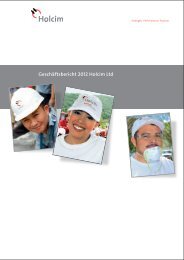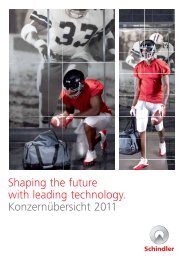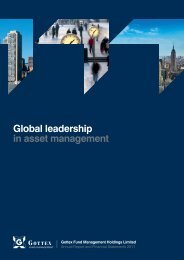Annual Report 2011 Holcim Ltd
Annual Report 2011 Holcim Ltd
Annual Report 2011 Holcim Ltd
Create successful ePaper yourself
Turn your PDF publications into a flip-book with our unique Google optimized e-Paper software.
110<br />
Faster learning organization<br />
Founded on the principle of decentralized<br />
leadership, “Holderbank”<br />
began implementing a personnel<br />
strategy centered on the principle<br />
of a “faster learning organization”. It<br />
did so in the conviction that classic<br />
hierarchical thinking was out of<br />
date. Instead, “Holderbank” emphasized<br />
consensus and motivation, in<br />
order to better utilize the abilities of<br />
its staff in the service of the Group<br />
as a whole. Such an approach allows<br />
for more freedom of action, but also<br />
requires a more deliberate delegation<br />
of many tasks. Employees and<br />
managers are encouraged to experiment<br />
to a certain degree, and to<br />
take calculated risks. This in turn<br />
demands increased flexibility from<br />
managers, as they have to respond<br />
quickly to problems that arise – a<br />
leadership principle which has in the<br />
meantime become part of many successful<br />
companies. “Holderbank” was<br />
in many ways predestined for such a<br />
leadership philosophy, as one of the<br />
key preconditions for it, a common<br />
goal to be pursued by all levels of the<br />
organization, is a given considering<br />
the nature of the Swiss cement<br />
group: in its case, a strict focus on<br />
core competencies. It’s also a principle<br />
which <strong>Holcim</strong> employees worldwide<br />
follow to this day and which is one of<br />
the key factors in the Group’s success.<br />
<strong>Holcim</strong> supports training and education following the principle of a “Faster<br />
learning organization”.<br />
It took just under 80 years for three generations of Swiss entrepreneurs, starting<br />
with a single cement factory in Holderbank in the Swiss canton of Aargau,<br />
to build a group of companies with worldwide annual sales of over six billion<br />
Swiss francs’ worth of cement, aggregate materials and ready-mix concrete.<br />
It would take less than ten years to add another six billion and double annual<br />
sales on all five continents. Like few other Swiss companies, “Holderbank” was<br />
able to take advantage of the climate in the 1990s to break into new markets<br />
and expand its share of existing markets. A major focus was the post-communist<br />
acquisitions of outdated state-run operations in Eastern Europe and the subsequent<br />
revamping of their production equipment – a process which continues<br />
to this day. Markets in Western Europe as well as in North and Latin America<br />
were also “rounded out”, accompanied by extensive restructuring programs,<br />
resulting in a substantial increase in earnings at almost all levels.<br />
In its home market, the ninth decade of “Holderbank” started with a bang with<br />
an announcement in the summer of 1992. The Neue Zürcher Zeitung (NZZ) went<br />
so far as to describe it as one of the “most important reorganizations of recent<br />
decades”. Via acquisitions and a regrouping of its holdings, Thomas Schmidheiny<br />
initiated one of the most far-reaching restructurings the Swiss construction<br />
materials market had ever seen. Over half of the Swiss cement market was now<br />
united under the aegis of the newly formed “Holderbank” Cement und Beton<br />
AG (HCB). After more than eighty years, E. G. Portland was dissolved, marking<br />
the end of the Swiss cement cartel. This came amid a general trend towards<br />
consolidation in the cement industry. The increasing pressure of market liberalization<br />
within the European Union and through the World Trade Organization<br />
(WTO) – which, under the Uruguay Round, was taking<br />
steps to open markets worldwide – was also a key<br />
motivation behind restructuring “Holderbank” in<br />
Switzerland. Just two years after the repositioning,<br />
the shareholders of the Société Suisse de Ciment<br />
Portland SA ceded half their shares to Thomas<br />
Schmidheiny, including nine percent of the votes<br />
in “Holderbank”. This secured the entrepreneur<br />
from St. Gallen 57 percent of the votes in the Group.

















